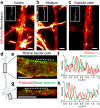Subcortical cytoskeleton periodicity throughout the nervous system
- PMID: 26947559
- PMCID: PMC4779989
- DOI: 10.1038/srep22741
Subcortical cytoskeleton periodicity throughout the nervous system
Abstract
Superresolution fluorescence microscopy recently revealed a ~190 nm periodic cytoskeleton lattice consisting of actin, spectrin, and other proteins underneath the membrane of cultured hippocampal neurons. Whether the periodic cytoskeleton lattice is a structural feature of all neurons and how it is modified when axons are ensheathed by myelin forming glial cells is not known. Here, STED nanoscopy is used to demonstrate that this structure is a commonplace of virtually all neuron types in vitro. To check how the subcortical meshwork is modified during myelination, we studied sciatic nerve fibers from adult mice. Periodicity of both actin and spectrin was uncovered at the internodes, indicating no substantial differences between unmyelinated and myelinated axons. Remarkably, the actin/spectrin pattern was also detected in glial cells such as cultured oligodendrocyte precursor cells. Altogether our work shows that the periodic subcortical cytoskeletal meshwork is a fundamental characteristic of cells in the nervous system and is not a distinctive feature of neurons, as previously thought.
Conflict of interest statement
SWH owns shares of the companies Abberior and Abberior Instruments GmbH, producing superresolution STED dyes and microscopes, respectively.
Figures




References
-
- Schmitt H., Gozes I. & Littauer U. Z. Decrease in levels and rates of synthesis of tubulin and actin in developing rat brain. Brain Res 121, 327–342, (1977). - PubMed
-
- Goodman S. R. et al. A spectrin-like protein from mouse brain membranes: immunological and structural correlations with erythrocyte spectrin. Cell Motil 3, 635–647 (1983). - PubMed
-
- Bennett V., Davis J. & Fowler W. E. Brain spectrin, a membrane-associated protein related in structure and function to erythrocyte spectrin. Nature 299, 126–131 (1982). - PubMed
Publication types
MeSH terms
Substances
LinkOut - more resources
Full Text Sources
Other Literature Sources

